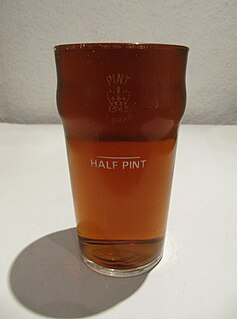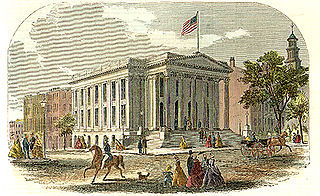Related Research Articles
A binary prefix is a unit prefix for multiples of units in data processing, data transmission, and digital information, principally in association with the bit and the byte, to indicate multiplication by a power of 2. As shown in the table to the right there are two sets of symbols for binary prefixes, one set established by International Electrotechnical Commission (IEC) and several other standards and trade organizations using two-letter symbols, e.g. Mi indicating 1,048,576 with a second set established by semiconductor industry convention using one-letter symbols, e.g., M also indicating 1,048,576.

The inch is a unit of length in the British imperial and the United States customary systems of measurement. It is equal to 1/36 yard or 1/12 of a foot. Derived from the Roman uncia ("twelfth"), the word inch is also sometimes used to translate similar units in other measurement systems, usually understood as deriving from the width of the human thumb.

The litre or liter is a metric unit of volume. It is equal to 1 cubic decimetre (dm3), 1000 cubic centimetres (cm3) or 0.001 cubic metre (m3). A cubic decimetre occupies a volume of 10 cm × 10 cm × 10 cm and is thus equal to one-thousandth of a cubic metre.
The pound or pound-mass is a unit of mass used in British imperial and United States customary systems of measurement. Various definitions have been used; the most common today is the international avoirdupois pound, which is legally defined as exactly 0.45359237 kilograms, and which is divided into 16 avoirdupois ounces. The international standard symbol for the avoirdupois pound is lb; an alternative symbol is lbm, #, and ℔ or ″̶.
The International System of Units, known by the international abbreviation SI in all languages and sometimes pleonastically as the SI system, is the modern form of the metric system and based on the metre as the unit of length and either the kilogram as the unit of mass or the kilogram-force as the unit of force.</ref> and the world's most widely used system of measurement. Established and maintained by the General Conference on Weights and Measures (CGPM), it is the only system of measurement with an official status in nearly every country in the world, employed in science, technology, industry, and everyday commerce.

The tonne is a metric unit of mass equal to 1,000 kilograms. It is also referred to as a metric ton to distinguish it from the non-metric units of the short ton, and the long ton. It is equivalent to approximately 2,204.6 pounds, 1.102 short tons, and 0.984 long tons. The official SI unit is the megagram, a less common way to express the same mass.

United States customary units form a system of measurement units commonly used in the United States and U.S. territories since being standardized and adopted in 1832. The United States customary system developed from English units which were in use in the British Empire before the U.S. became an independent country. The United Kingdom's system of measures was overhauled in 1824 to create the imperial system, which was officially adopted in 1826, changing the definitions of some of its units. Consequently, while many U.S. units are essentially similar to their imperial counterparts, there are significant differences between the systems.
The pound of force or pound-force is a unit of force used in some systems of measurement, including English Engineering units and the foot–pound–second system.

The cubic inch is a unit of volume in the Imperial units and United States customary units systems. It is the volume of a cube with each of its three dimensions being one inch long which is equivalent to 1/231 of a US gallon.

The pint is a unit of volume or capacity in both the imperial and United States customary measurement systems. In both of those systems it is traditionally one eighth of a gallon. The British imperial pint is about 20% larger than the American pint because the two systems are defined differently. Almost all other countries have standardized on the metric system, so although some of them still also have traditional units called pints, the volume varies by regional custom.
The cubic foot is an imperial and US customary (non-metric) unit of volume, used in the United States and the United Kingdom. It is defined as the volume of a cube with sides of one foot in length. Its volume is 28.3168 L.
A cubic yard is an Imperial / U.S. customary unit of volume, used in Canada and the United States. It is defined as the volume of a cube with sides of 1 yard in length.
The foot-pound force is a unit of work or energy in the engineering and gravitational systems in United States customary and imperial units of measure. It is the energy transferred upon applying a force of one pound-force (lbf) through a linear displacement of one foot. The corresponding SI unit is the joule.

Metrication is the process of introducing the International System of Units, also known as SI units or the metric system, to replace a jurisdiction's traditional measuring units. U.S. customary units have been defined in terms of metric units since the 19th century, and the SI has been the "preferred system of weights and measures for United States trade and commerce" since 1975 according to United States law. However, conversion was not mandatory and many industries chose not to convert, and U.S. customary units remain in common use in many industries as well as in governmental use. Unlike other countries, there is no governmental or major social desire to implement further metrication.
IEEE 1541-2002 is a standard issued in 2002 by the Institute of Electrical and Electronics Engineers (IEEE) concerning the use of prefixes for binary multiples of units of measurement related to digital electronics and computing.
The foot–pound–second system or FPS system is a system of units built on three fundamental units: the foot for length, the (avoirdupois) pound for either mass or force, and the second for time.
The stilb (sb) is the CGS unit of luminance for objects that are not self-luminous. It is equal to one candela per square centimeter or 104 nits (candelas per square meter). The name was coined by the French physicist André Blondel around 1920. It comes from the Greek word stilbein (στίλβειν), meaning 'to glitter'.

The pound per square inch or, more accurately, pound-force per square inch is a unit of pressure or of stress based on avoirdupois units. It is the pressure resulting from a force of one pound-force applied to an area of one square inch. In SI units, 1 psi is approximately equal to 6895 Pa.
A pound-foot (lbf⋅ft) is a unit of torque representing one pound of force acting at a perpendicular distance of one foot from a pivot point. Conversely one pound-foot is the moment about an axis that applies one pound-force at a radius of one foot.

The imperial and US customary measurement systems are both derived from an earlier English system of measurement which in turn can be traced back to Ancient Roman units of measurement, and Carolingian and Saxon units of measure.
References
- ↑ "260.1-2004 – IEEE Standard Letter Symbols for Units of Measurement (SI Customary Inch-Pound Units, and Certain Other Units)". standards.ieee.org. Retrieved 2021-05-10.